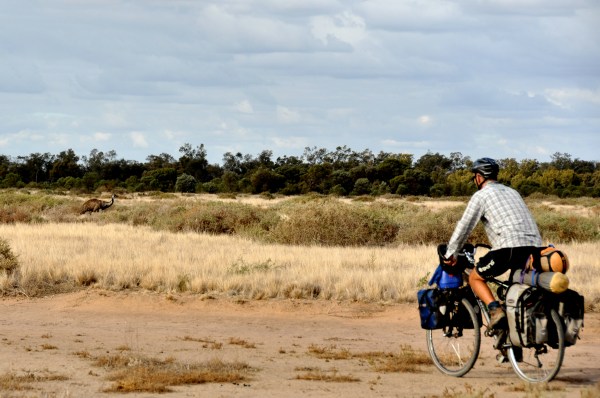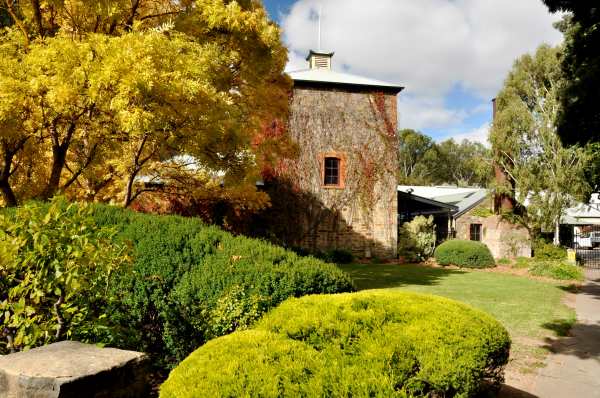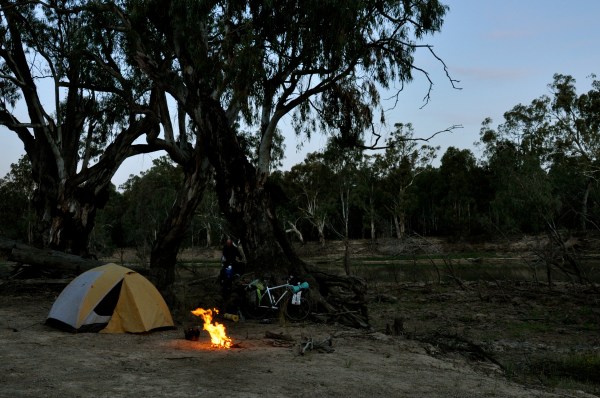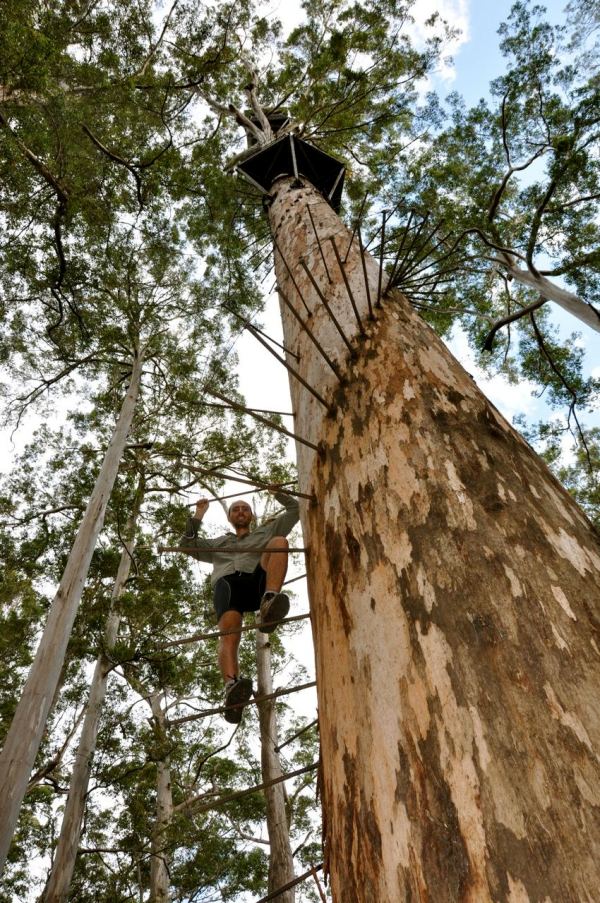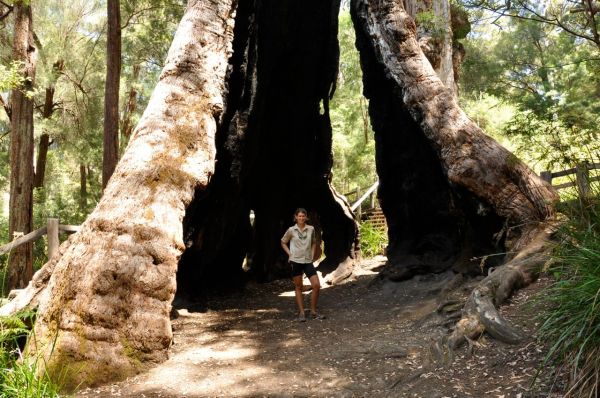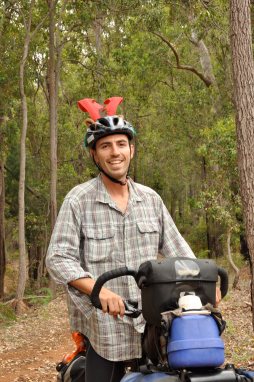The Home Stretch
For almost two years we’d planned on cycling through Victoria, taking the ferry to Tasmania and spending a few weeks on winding roads, exploring National Parks and soaking up the greenery. If we’ve learned nothing else on this trip of ours, it’s that plans never go to plan! By the time we reached Mildura in northwest Victoria, the days and nights were getting very cold, and the idea of a cold and soggy Tassie circumnavigation was rather unappealing. So next time Gadget! Hopefully we can make it to our most southern state next summer when the weather is more hospitable.
Apart from weather considerations, another factor in this decision was finding out about Boxgum Grazing during our travels. Sam and Claire of Boxgum produce free-range pastured pork and cell graze their cattle, and we were very keen to check out what they are doing and learn a thing or two with a view to grazing our own property one day. Fortunately they were more than happy to have us, so from Mildura we made a beeline for Young, NSW.
After following the Murray a little way through northern Victoria and savouring the beautiful campsites, we crossed into NSW on 21st April. It had been one year and eight months since we left our home state. We were rained on in welcome, and spent the night under a bridge on the NSW side of the Murray, looking back over the river into Victoria.
Smaller roads have been appealing more often than not throughout our journey, as they are usually quiet and scenic compared to the larger alternative. However as we neared the more populated east coast, even the smaller roads carried big fast trucks, and there was no shoulder to hide on. Tired of being forced off the road into gravel and glass and faffing around on unnamed or unmarked roads, we decided it was time to hit the highway and head for home. Surprisingly the highway wasn’t as bad as we’d imagined. There was a smooth wide shoulder giving the illusion of safety, there were fewer steep climbs, and we could put our earphones in and listen to podcasts, music, or the soothing voice of David Attenborough for entertainment.

Another flat field, this time filled with cotton. People who claim the Nullarbor is flat and boring should see the Hay Plains, which actually are flat and boring. All the farming makes for a monotonous and windy ride. Give me the Nullarbor over that any day!
Having been away from the east coast and the Great Dividing Range for so long, it was easy to forget what climbing hill after hill feels like, wondering if our lactic-heavy legs are going to make it top or if we’ll have to get off and push. Riding into and out of Young we were reacquainted with this challenge. We also rediscovered how much fun descending is, often easily hitting 60km/h on the way down and getting a little run-up for the next lung-buster.
Stopping at Boxgum when we were so close to home was difficult, but it turned out to be our favourite farm we have worked on throughout our whole trip, and a fitting way to start bringing our journey to a close. Sam, Claire and Annabel made us feel very welcome and we learned an enormous amount, not just about the actual practice of cell grazing, but also about being a farmer and caring for your livestock and your land.
What had the greatest impact on us both at Boxgum was how much can be achieved by grazing animals appropriately and with a sensitivity to the land on which they are living. Grazing animals can be used with amazing effectiveness to restore degraded and overgrazed land, increase biodiversity and improve resilience, whilst also giving you a livelihood! Furthermore, this method of grazing actually sequesters carbon – something for the vegetarians out there to mull over. To understand what we’re talking about, watch Allan Savoury’s TED Talk, it’ll give you an idea of what can be achieved if we break with old-school conventional thinking and instead look to environmental patterns and processes for agricultural guidance.
The other Boxgum highlight was undoubtedly the piglets! I’m surprised Christian didn’t try to ride off with one hidden in his pannier, though I guess it’s squealing would have been a giveaway.

The weaner piglets trying to get pats from Christian, or maybe they were just trying to chew his boots.
The frosty Boxgum mornings followed us as we set off for home, with a cold front moving across NSW bringing rain and cooling things down even more. Thoughts of ugg boots, hot baths and family reunions kept us going, and soon we were seeing landmarks from our practice cycle trip to Wombeyan Caves almost two years before. Not far to go!!
At Rosann’s place the night before we reached home, everything felt surreal. The next day would be our last on the bike (for this trip anyway) and it was both exciting and a bit sad. In a grand finale we accidentally took the hilliest route possible from Wilton to Bulli, then enjoyed a final stretch of dirt down through the Illawarra Escarpment State Conservation Area. From the top of the Escarpment the view was almost magical, with a calm sapphire blue ocean, clear skies and warm sunny day. The huge contrast between the brown dry west and the lush green vegetation on the escarpment was striking, and we never considered Wollongong to be such a beautiful place. It was good to be home.
Both of us somehow made it up the crazy-steep driveway, to the applause of my little sister and friend Sally, before our parents joined in and there were hugs and smiles all round.

Home at last! Even Jack wanted to say hello. We both stood there for a while not wanting to get off our bikes.
For the number crunchers, at the top of the driveway, the end of our circumnavigation of Australia, we’d pedalled 15,979 kms. It had taken us 221 days of cycling (admittedly spread over 21 months, it was a holiday after all) and 940 hours in the saddle, with 16 flat tyres between us. I convincingly won the stack points competition, with 38 points to Christian’s 26. For those people along the way who asked how heavy our bikes were, sorry we never had an answer. On finishing, minus food and water, Christian’s bike and gear weighed 55kg, and mine weighed 45kg. That means when we set off across the Nullarbor Christian’s bike would have weighed about 80kgs and mine about 65kgs!
By the way, there are still a couple more weeks to donate to our Bush Heritage Fundraising effort, to help buy back Australia’s unique land and protect it forever!
One refreshing night’s sleep later there was a great big family lunch thanks to Clara and Philip, with a yummy cake saying ‘Welcome home Jayne and Christian – the Permie Pedalers’. Might be a while before we head off cycling again…though we are taking suggestions for destinations…
From Sea Lions to the River Murray
South Australia seems small compared to the vastness of Western Australia. Looking at our maps, towns seemed much closer together than in WA, meaning simplified food and water logistics and more fresh fruit and veg – definitely something we were looking forward to. We also had a few friends to visit and their concomitant couches to stay on and showers to use, all exciting prospects.
The natural beauty of South Australia took us by surprise though, and thankfully forced us to slow down, reminding us to enjoy the adventure at a time when we were unwittingly quickening our pace towards the east coast.

Christian shucking fresh oysters in Smokey Bay where they are grown; the going rate was only $7.50/kg
Huge fresh oysters, shucked ourselves and enjoyed by the water in Smokey Bay, were a promising introduction to the Eyre Peninsula. A friend’s parents made us welcome in Streaky Bay, an area with dramatic rugged coastlines but also well known for great whites – no swimming for us! Bob and Glennis showed us the sights, including deserted beaches and the only permanent sea lion colony on the Australian mainland, at Point Labatt. Down in Baird Bay we even swam (with a shark shield) with the sea lions and dolphins, an amazingly memorable experience.
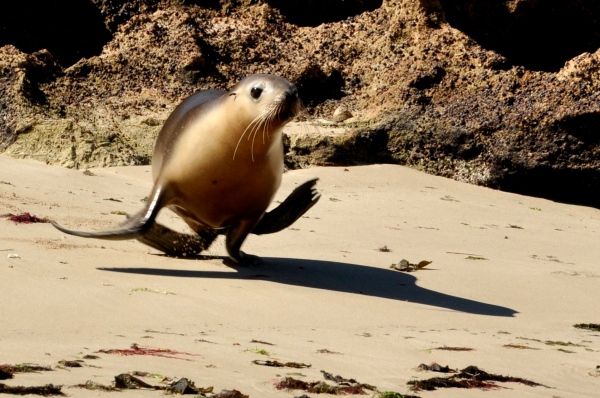
Sea lion pup running into the water to say hello; they were very curious and amazing aquatic acrobats
Cutting across the top of the Eyre Peninsula, we travelled through open wheat and sheep country, which became the norm through much of South Australia. To amuse ourselves we often listened to podcasts, and Christian started an extensive acacia seed collection.
Nearing Port Augusta, mountain ranges could be seen in profile along the horizon, an impressive contrast to the surrounding flat brown land. We skirted around the foot of these mountains – the southern Flinders Ranges – admiring their rugged lines and being thankful we didn’t have to cycle through them!
Our self-described ‘bearded crazy’ friend Patrick lived on a property near Port Pirie, backed into the southern Flinders and looking out over the Spencer Gulf below. We’d met him way back at Hells Gate in northwest Queensland where he was on a caravanning adventure, and ran into him again a handful of times afterwards. While staying with Patrick for a few days over Easter, we hiked into beautiful Telowie Gorge at dusk in search of the rare yellow-footed rock wallaby (which remained elusive), sampled local produce at the friendly Wirrabarra Markets on the other side of the range, returning via a fun 4WD track with amazing views over the mountains, and had many an interesting conversation in the kitchen.
Making a beeline from Port Pirie to the Clare Valley, our legs screamed in protest as we found ourselves in real hills once again. We’d forgotten what it felt like to climb constantly up and down all day, crossing valleys and rivers, and collapsing in satisfied exhaustion at the end of the day.
After all the wheat and sheep, descending into the Clare seemed like a mirage. Literally as we came over a crest and started into the valley, suddenly everything was lush and green and there were shady trees growing by the side of the road. Once in the valley proper you’d be hard-pressed to find a slope that wasn’t occupied by a vineyard. Aside from the expected abundance of grapes, there was also a fantastic variety of food growing wild by the road – in two days we picked peaches, apples, almonds, rosehips, fennel seeds, prunes, olives and found some quinces that weren’t quite ready.
Best known for it’s Rieslings, the Clare Valley is one of Australia’s oldest wine regions and home to the ‘Riesling Trail’, part of South Australia’s 900km Mawson Trail. The Riesling Trail joins Clare in the north to Auburn in the south, passing many cellar doors along the way. Built on an old section of railway line that existed until the 1950s, the Trail is mostly a gentle downhill from north to south.
It was a very welcome change to be riding on a smooth, quiet car-free path, surrounded by shady trees with bright autumn leaves. We had to work for our wines though, with almost every cellar door being perched on the very top of hills (not far off the trail) with heart-breaking climbs but stellar views.
We cycled most of the way from Clare to Auburn with a couple from Brisbane who were regular visitors to the area and shared their favourite cellar doors with us. However when we arrived in Auburn and went our separate ways, we were disappointed to find the two wineries we had most wanted to visit were closed! So we turned around and started back up the hill with no wine to show for it…gradients don’t seem so gentle when you’re travelling up them…only to find our third planned stop was also closed!
Thinking our whole visit would be a flop, we persevered and luckily things improved, and we visited 3 wineries we thought were great and a 4th that was ok. As in Margaret River WA, there were too many to visit all in one day and Christian’s research paid off.
It was back to wheat and sheep after we left the Clare, taking a section of the Mawson Trail to heritage-listed Burra. It wasn’t Burra’s historic buildings or colourful gardens that were the highlight for us, it was Christian’s flat tyre. Times two. Because as we were repairing the tyre for the second time in the shade of a huge carob tree, we found two unopened, brand-spanking new bottles of wine, and they were delicious!
Continuing eastwards, the nights and mornings were becoming colder, and sometimes we even cycled in big gloves, jumpers and raincoats early in the morning. Our first encounter with the mighty River Murray was in the little town of Morgan, and from there we took a quiet road that hugged the northern bank all the way to Berri. The road was often far above the river, as the northern bank was very steep and much higher than the southern bank, and there were great views up and down the river giving us an appreciation of how huge it really is.

Lake Bonny, near Berri and beside the River Murray; the drowned red gums are a reminder of the huge changes people have made to natural flows along the length of the Murray
Instead of following the SA coast, we had decided to go cross-country in order to camp along the banks of the Murray, something neither of us had done before. This route also meant we could visit Ellen and Luke in Berri, where we had such a great time we almost didn’t leave! Ellen took us canoeing on the quiet waters of a tributary of the Murray, watching birds and winding through trees and up little creeks. Between the four of us we had numerous amazing cook-ups, including a pretzel, pilsner and poker night and a campfire in the front yard. We went on picnics and walks through the bush. Luke and Christian made some wicking beds for growing vegies. Christian had his fix of compost-making and I had my fix of David Attenborough. Then to top everything off we spent four and a half hours at Stefano’s in Mildura, celebrating Christian’s birthday over a long and incredible lunch. You can see why we didn’t want to leave.
But the weather was becoming colder, the days were getting shorter, and we really didn’t want to be on the road in winter again. I admit it, I am a cold wimp. So it was onwards and eastwards, following the Murray into Victoria, through Murray-Sunset National Park to Mildura. It was a tough, sandy and rather unpleasant road, but we were rewarded with secluded riverside camps, swimming and fantastic bird watching. Some of the most memorable moments of our whole adventure have been in out-of-the-way camps, the sun sinking below the trees and creating stunning colours in the sky, and all accompanied by birds chattering away.

Murray-Sunset National Park; the enjoyment of not having cars around didn’t quite make up for regularly having to get off and push our bikes through sand
However, after Mildura we agreed no more dirt roads, especially if they looked sandy; we’d had our fill and just wanted to head home. Via a couple of other places of course…
The Mighty Nullarbor…scared?
Hours had passed and the rain was still pounding our tent, threatening to soak us and our gear. It was day three of our cycle across the Nullarbor, and heavy, relentless rain was the last thing we had expected on this leg of our journey.
During our time in Esperance, where we spent almost one month HelpXing at Tina and Winton’s place – learning about solar power and biodiesel, and swimming at Australia’s most beautiful beaches – we’d obsessed over weather forecasts for this world-famous stretch of bitumen that lay ahead. Almost invariably the forecasts predicted roaring easterly winds, sometimes with a little north or south in them, and often searing temperatures in the low-forties.
By the end of February temperatures were more reasonable, but the wind remained strong as ever. With iPods fully charged and panniers stuffed with more food than previously thought possible, we set off, daunted by what lay ahead. We weren’t so much scared of the actual route, more of the weather we expected to encounter along it.
In some ways our trepidation added to our sense of excitement. ‘The Nullarbor’ – a name frequently used in reference to the area between Norseman in the west and Ceduna in South Australia, but actually describing the largest single piece of flat limestone in the world and the treeless plain it supports. Crossing it would be our final long stretch between towns in our cycle around Australia, and from Ceduna towns would be much closer together all the way home.
From Esperance we cycled north, turning right at Norseman. Hello Nullarbor! And hello wind…we started plodding along in to the gusting easterly, finding it a novelty at first and happy just to be moving forward, no matter what the speed. Only 1200kms to the next town!
Day two was equally windy, with clouds beginning to gather all around on the horizon. We finished our day of plodding and parked the tent by the edge of an impressive salt lake. The white salt crust, orange sand and sky as the sun set were beautiful. We wouldn’t be seeing the sun for a few days after that.
Our fingers were so cold they went numb, squelchy puddles in our shoes, shivering, wearing rain pants for the first time in over a year, and soggy honey sandwiches – what a day! We hadn’t considered the possibility of rain – in fact the only water we were worried about was the lack of it – and for the first time ever we actually had to set the tent up while it was pouring. The ground was boggy and we were worried about the tent floor letting water through, as this has been a major problem in the past. So we made a bed of bark, set everything up at double-speed and jumped inside, eager to crawl into sleeping bags and warm up. It wasn’t even 12 noon yet.
Following a very wet day and night, suddenly there were small lakes all along the roadside where previously there’d been dry crunchy ground. The rain continued all that day, if only as a fine mist. Despite most of our camping stuff being sopping wet, we actually felt lucky to be on bicycles; literally hundreds of frogs had appeared, frolicking in the pools of water, their croaking surrounding us – and people speeding by in their cars were missing this amazing experience!
During the two weeks it took us to cycle from Norseman to Ceduna (including one rest day) we were often happy to be cycling rather than driving, which many people do in just two days. At first the Nullarbor had simply been an unavoidable part of cycling around the continent – a long, empty stretch of road separating us on the west coast from home on the east coast. But then we encountered the frogs, and so many other surprises along this stretch: there were far more trees (and shade) than we had expected; there were impressive salt lakes, empty plains and ‘breathing’ caves; there were bumps and turns rather than a flat straight road the whole way as we’d been told; the sunrises were nothing short of spectacular, with their orange wisps of cloud seen over the distant horizon. Then the stars came out…

As we started early to avoid some of the wind, most mornings we were rewarded with a beautiful sunrise
There were emus, wedge-tailed eagles, endangered pink cockatoos and in South Australia especially lots of birds we had never seen before. At night sometimes we could hear dingoes howling. The Bunda Cliffs were spectacular, putting Victoria’s Great Ocean Road to shame. And the endless stream of friendly toots and waves from truckies and caravaners.

The Bunda Cliffs. We could see rain blow in off the ocean and waves crash against the cliff – all very dramatic…not much between here and Antarctica!
Oh and never let the idea of scarce water put you off cycling the Nullarbor – almost all the roadhouses were friendly and gave us drinkable water, as well as there being a couple of water tanks in rest areas along the way; water through here was far easier than in northern WA.
Sure some days were tough – strong winds, rain, scorching heat, sore bums, swollen Achilles tendons or a combination of these – but on those days we just chose an easy gear and plodded along, and when we were tired called it a day.
If we thought cycling was slow going, things were put into perspective when we met Matt & Wendy Napier near Penong. Matt is walking from Perth to Sydney – via Adelaide, Melbourne and Canberra and bouncing an AFL football the whole way – to raise awareness about global poverty. Since 1990 the number of people living in extreme poverty has been halved, and they want people to know that if we keep it up we can put a complete end to it. Amazing!! And really friendly people too, we were glad we had the opportunity to meet them…see where they’re at on their website and maybe walk a section with Matt, we’d highly recommend it!
Back near Norseman it felt like Ceduna was so far away, but as per usual before we knew it our Nullarbor crossing was complete. Celebratory fish and chips were in order, and of course a cold drink, a shower and a good night’s sleep.
Good shade, good food and good company
Tall shady forests of karri and tingle trees were a major highlight as we cycled east from Margaret River. In some ways it felt like we were on the final stretch – finally heading east towards home – and we had to remind ourselves there are still things to see and do along the way, not to mention crossing that big empty patch in the middle of the country.
Heatwaves rolled through the south west over Christmas and in the new year, bringing temperatures in the low 40s and memories of cycling through northern WA. Unlike the north though, around Pemberton we were treated to amazing forests of towering white trees and abundant shade, which felt surreal after having seen so much open land. We were in awe. Sometimes the karri forests grew right to the edge of the road, creating a shade tunnel as we wound around and up and down, travelling east.
.
.
.
.
.
.
.
.
.
.
.
.
.
.
We’d heard about karris being used as fire lookouts back in the settlement and logging days, so we pedalled through Warren National Park to check out the ‘Dave Evans Bicentennial Tree’. Though not the oldest fire lookout tree in the Pemberton area, it is the tallest of the remaining three lookouts, reaching 75m into the sky. They don’t come much taller than that.
Having never even seen photos of fire lookout trees before, we were curious as to how we’d climb to the top. All was revealed on arrival, and luckily everyone else was still in bed because it was scary enough with only two of us at the top! There were 130 pegs hammered horizontally into the tree’s trunk and surrounded by dodgy-looking chicken wire. The pegs spiralled around the trunk almost all the way to the top, where a lookout tower had been fashioned with four levels and ladders between. There wasn’t a breath of wind that day but when it gets gusty the 2-tonne tower sways up to 5 metres in each direction! A few of the pegs felt wobbly under our feet but luckily none came completely loose, apart from in my overactive imagination. The 360-degree view was impressive, looking over the national park to farmland and hills beyond. I wonder how much longer we’ll be allowed to do things like that?
Further along, the Walpole-Nornalup National Park is practically the only place in the world where giant tingle trees can be found. These trees can grow to over 400 years old, and are often characteristically hollow due to fires burning out the heartwood. Parking your car inside the hollow of a particularly enormous tingle used to be a classic holiday snap in the area. However, despite their size the trees actually have a very shallow and fragile root system, and eventually the poor abused tree keeled over and died. We checked out the now largest tingle tree, which happens to be the largest known living eucalypt in the world with a girth of 24m.
Sadly the forests didn’t continue all the way to Esperance, or even to Albany, and we found ourselves back out in the open with the March flies. Clouds of them!
Local produce was varied and we sampled whenever we could – mead, honey, cider, marron and grappa – and took away pannier-friendly treats for on the road. This part of Western Australia feels so far removed from the rest of the state!

Lots of wildlife around this area, including this Yellow tailed black cockatoo – listed as a ‘vulnerable species’
Denmark was a funny little alternative town with a disproportionately large number of cafes, and a fun place to spend my birthday. The bakery there was painfully amazing – how are you supposed to decide what to get when everything takes your fancy? –and Christian made a very yummy rice pudding birthday cake on our little camp stove at our campsite with ocean views 🙂
Next stop was Oranje Tractor Wine in Albany, an organic winery where we spent a little over a week WWOOFing. We learnt lots from Pam and Murray about growing grapes organically and making wine, and loved staying there. The wine was so good we had to send a carton home. Cumquats were also in over-abundance, and we had fun coming up with new and exciting cumquat recipes with plenty of willing guinea pigs around. Hopefully one day we can give our own WWOOFers such a memorable experience, as we were definitely sad to leave Oranje Tractor.
Pam and Murray put us in touch with their friends in Porongurup, our next stop, who also had a winery. Barry and Shelley welcomed us into their home and we had yet another great experience, leaving complete strangers as friends. Their property, Jingalla, had the Porongurup National Park as a dramatic backdrop, and while there we did a couple of walks up through the park. Nancy’s Peak was the best, with views to the ocean in one direction and to the impressive Stirling Range, our next destination, in the other. Barry also took us on our first ever beach fishing adventure, and it was even successful!
Our ride out to the Stirling Range was not far from Jingalla, but it was a very hot sweaty day. For some reason we followed the cycle up with a steep rocky hike to the summit of Mt Toolbranup, the second highest peak in the range (1052m). From the summit we were treated to spectacular 360-degree views, this time over the Stirling Range to the surrounding plains. The Stirling Range is interesting as it rises suddenly, as a chain of green pimples, out of the surrounding flat brown farmland. This also means it is visible in all directions from quite a distance.
After another week of mallee scrub and crossing river valleys (do you know that song remixed from the old Arnie aerobics videos? Down, up, down, up…more energy! We sang that pretty often) we arrived in Esperance on Australia Day. About 20kms out of Esperance we found we had phone reception…and could listen to Triple J’s Hottest 100 countdown online! It lifted our spirits (and our speed) feeling part of the Australia Day celebrations while cycling in the heat, with Esperance creeping into view, grooving along to new music we mostly hadn’t heard before. Then the battery died, but by that time we’d practically reached Tina and Winton’s place, where we’d be Help-Xing for the next couple of weeks. Their own celebrations were in full swing, and we happily demolished the rest of the BBQ lunch and cracked a beer. What a welcome!
A Path Through the Forest
The Munda Biddi Trail (meaning ‘path through the forest’ in the Aboriginal Noongar language) is soon to become the longest off-road cycle trail in the world, covering more than 1000kms between Mundaring (35kms east of Perth) and Albany. There is just one more section of trail to be completed, from Manjimup to Denmark, due to open later this year. Considering this impressive claim to fame, we decided to give our steeds an off-road workout and follow the trail as it winds its way south.
Christmas was looming as we cycled out of Perth, dressed to the nines in stylish matching reindeer antlers. We must have radiated festive spirit – the number of times people yelled out ‘Merry Christmas’ or ‘Hi Donner and Blitzen’ from cars, bicycles and worksites was astonishing. It all felt very jolly and put us in great spirits.
If you have an eye for detail and memory for figures, you may have noticed a gradual increase in Stack Points in the ‘Stats’ box on the right since we departed Cairns; well our week on the Munda Biddi saw the points tally skyrocket! There was even a spectacular collision between a misplaced tree and myself; my left rear pannier was torn completely off its fixings and left in the dust as I went out of control down a small rocky hill. Maximum stack points for that one. At the time it was becoming dark, we had taken a wrong turn down a firetrail and were frantically looking for a hut we knew was nearby. Talk about timing.
The trail had started rather innocuously; smooth dirt doubletrack leading down to the Mundaring Weir, then climbing up the other side of the valley along rough fire trail, with some meandering singletrack thrown in here and there to sweeten things up. All was surrounded by eucalypt forest and not a car in sight. The overpriced but brilliantly detailed Munda Biddi Trail map indicated this section was rated ‘medium difficulty’. A reasonable rating we thought, and assumed most of the trail should therefore be rideable. Only a few sections between Mundaring and Collie, our planned exit point, were marked ‘hard’, and all were short enough to walk if need be.
Note to self: assumptions only lead to disappointment.
The track rapidly deteriorated as we continued climbing out from the Weir. Whoever built this section obviously hadn’t heard of the concept of using switchbacks or putting in water bars to prevent washout, and there were deep ruts carved the width of the trail that made bush-bashing look like a better option. The gradient became so steep it was laughable – even the pros would be lucky to get through on an unloaded mountain bike, never mind a bike carrying overnight camping gear and food – the sort of cycling the trail is marketed to. The surface was covered in small loose rocks that felt like walking on marbles. It took both of us to haul one bike to the top, occasionally finding ourselves slipping backwards down the hill.
To make things even more interesting, while we were taking two steps forward and one back out came the march flies in a veritable cloud. There were so many of them we couldn’t slap our arms and legs fast enough, they could bite through our clothes and whenever we slowed down a little they’d be on us. The march fly dance was our only option; a crazy waving of limbs and stomping of feet with strangled yelps of pain and anger. So ended our first day on the Munda Biddi.
Day two presented a different kind of challenge: ankle deep pea gravel, which our tyres sank into like deep soft sand. Half the day was spent trying to haul our bikes along and making painfully slow progress. When we could ride we made the most of it, and pulled off some impressive stacks. Christian had a particularly good slow-motion wipeout around a deep sandy corner.
The Munda Biddi Trail wasn’t all bad though. We didn’t have to fight any cars. There was lots of wildlife, including birds, snakes, emus and small marsupials. Our new macro lens was well used on the abundant wildflowers. We really loved being surrounded by forest and shade. Best of all, spaced at convenient intervals along the trail were fantastic huts with undercover picnic tables, bunks, rainwater tanks and bicycle racks. They felt very luxurious compared to a random patch of ground amongst spiky bushes, and were certainly a sight for sore legs at the end of the day.
Each hut had a unique character; Wungong Campsite was surrounded by towering jarrah forest; Dandalup was set into an escarpment overlooking the distant lights of coastal towns; from the picnic table at Bidgar Ngoulin campsite we could hear a small stream gurgling over rocks and a refreshing swimming hole; and Yarri campsite was set into the side of a valley overlooking the forest. Unbelievably we had them all to ourselves!
Not only was it a real treat to stay in the huts most nights, we also enjoyed reading about other cyclist’s experiences on the trail in each ‘Campsite Logbook’. Some riders made only brief remarks on trail conditions and the weather, while others wrote entertaining entries that continued in instalments from one hut to the next. There were even poems and drawings. From these logbooks we discovered we were not alone in feeling the pea gravel was to be feared and loathed. We sympathised with others who did it tough, and felt we were not being overly critical in thinking the condition of this section was disappointing.
Encouragingly, cyclists who had ridden from south to north (the opposite direction to us) noted that the trail improved dramatically south of Dwellingup, and it did. Hooray! Our enjoyment also increased dramatically – fun winding trail through the forest, ups and downs and tight corners, challenging patches of sand and even a couple of small jumps. This was what we’d come for! It was almost a shame to arrive in Collie, however Busselton and Margaret River were waiting and we reluctantly left the Munda Biddi for the coast.
Christmas was only four days away as we cycled towards Busselton. The number of toots, waves and adults behind the wheel having a good giggle was off the charts! We didn’t mind the antlers getting caught on trees all the way along the trail if it meant so much Christmas cheer!
Busselton is home to the longest wooden jetty in the southern hemisphere, sticking out 2kms into Geographe Bay. We saw more than most as we went diving around the pylons at the end of the jetty, between towers of amazingly coloured soft corals growing on the surface of the pylons.
The number of wineries in the South West was overwhelming. Christian’s penchant for researching places to eat came to the fore, as he chose a handful that looked promising and most turned out to be a great. If you’re ever in the area, St Aidens in the Ferguson Valley was a standout for delicious whites and friendly service, as was Juniper Estate for reds. And the wineries weren’t the only attractions: Gabriel Chocolate was the best chocolate experience of my short life! They roast cacao beans from around the world and have a generous range to try, handmade with only simple ingredients and you can actually taste the difference between beans from around the world. It was really interesting.
So we arrived in Margaret River for Christmas, our panniers stocked with all sorts of treats J We had a couple of days relaxing at a guesthouse – away from the march flies, with a fridge for our goodies and even a bath! The highlight of our Christmas was definitely the bath.
